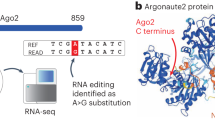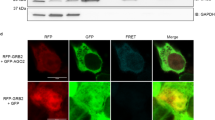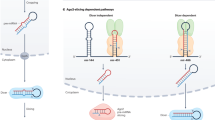Abstract
MicroRNAs (miRNAs) are short noncoding RNAs of cellular1 and viral origin2,3,4,5,6,7 that post-transcriptionally regulate gene expression through imperfect base pairing to their mRNA targets. Because the recognition sequences of miRNAs for their targets are short and may be discontinuous, bioinformatic prediction of targets is difficult. Here we present an approach to the experimental identification of the mRNA targets of miRNAs encoded by the Kaposi's sarcoma–associated herpesvirus (KSHV). KSHV encodes 17 miRNAs, derived from 12 pre-miRNAs expressed from a single locus during viral latency2,5,6,7,8,9,10. We conducted multiple screens that examine small changes in transcript abundance under different conditions of miRNA expression or inhibition and then searched the identified transcripts for seed sequence matches. Using this strategy, we identified BCLAF1, encoding Bcl2-associated factor, as a target for miR-K5, and further analysis revealed that several other KSHV miRNAs also target this gene product. Our results support that this type of expression profiling provides a potentially general approach to the identification of miRNA targets.
This is a preview of subscription content, access via your institution
Access options
Subscribe to this journal
Receive 12 print issues and online access
$209.00 per year
only $17.42 per issue
Buy this article
- Purchase on Springer Link
- Instant access to full article PDF
Prices may be subject to local taxes which are calculated during checkout





Similar content being viewed by others
Accession codes
References
Landgraf, P. et al. A mammalian microRNA expression atlas based on small RNA library sequencing. Cell 129, 1401–1414 (2007).
Pfeffer, S. et al. Identification of microRNAs of the herpesvirus family. Nat. Methods 2, 269–276 (2005).
Sullivan, C. & Ganem, D. MicroRNAs and viral infection. Mol. Cell 20, 3–7 (2005).
Stern-Ginossar, N. et al. Host immune system gene targeting by a viral miRNA. Science 317, 376–381 (2007).
Cai, X. et al. Kaposi's sarcoma-associated herpesvirus expresses an array of viral microRNAs in latently infected cells. Proc. Natl. Acad. Sci. USA 102, 5570–5575 (2005).
Samols, M.A., Hu, J., Skalsky, R.L. & Renne, R. Cloning and identification of a microRNA cluster within the latency-associated region of Kaposi's sarcoma-associated herpesvirus. J. Virol. 79, 9301–9305 (2005).
Grundhoff, A., Sullivan, C. & Ganem, D. A combined computational and microarray-based approach identifies novel microRNAs encoded by human gamma-herpesviruses. RNA 12, 733–750 (2006).
Samols, M. et al. Identification of cellular genes targeted by KSHV-encoded microRNAs. PLoS Pathog. 3, e65 (2007).
Skalsky, R.L. et al. Kaposi's sarcoma-associated herpesvirus encodes an ortholog of miR-155. J. Virol. 81, 12836–12845 (2007).
Gottwein, E. et al. A viral microRNA functions as an orthologue of cellular miR-155. Nature 450, 1096–1099 (2007).
Krützfeldt, J. et al. Silencing of microRNAs in vivo with 'antagomirs'. Nature 438, 685–689 (2005).
Giraldez, A.J. et al. Zebrafish MiR-430 promotes deadenylation and clearance of maternal mRNAs. Science 312, 75–79 (2006).
Lim, L. et al. Microarray analysis shows that some microRNAs downregulate large numbers of target mRNAs. Nature 433, 769–773 (2005).
Rodriguez, A. et al. Requirement of bic/microRNA-155 for normal immune function. Science 316, 608–611 (2007).
Meister, G., Landthaler, M., Dorsett, Y. & Tuschl, T. Sequence-specific inhibition of microRNA- and siRNA-induced RNA silencing. RNA 10, 544–550 (2004).
Hutvagner, G., Simard, M.J., Mello, C.C. & Zamore, P.D. Sequence-specific inhibition of small RNA function. PLoS Biol. 2, E98 (2004).
Grimson, A. et al. MicroRNA targeting specificity in mammals: determinants beyond seed pairing. Mol. Cell 27, 91–105 (2007).
Selbach, M. et al. Widespread changes in protein synthesis induced by microRNAs. Nature 455, 58–63 (2008).
Baek, D. et al. The impact of microRNAs on protein output. Nature 455, 64–71 (2008).
Gottwein, E., Cai, X. & Cullen, B.R. A novel assay for viral microRNA function identifies a single nucleotide polymorphism that affects Drosha processing. J. Virol. 80, 5321–5326 (2006).
Didiano, D. & Hobert, O. Perfect seed pairing is not a generally reliable predictor for miRNA-target interactions. Nat. Struct. Mol. Biol. 13, 849–851 (2006).
Reinhart, B.J. et al. The 21-nucleotide let-7 RNA regulates developmental timing in Caenorhabditis elegans. Nature 403, 901–906 (2000).
Yekta, S., Shih, I.H. & Bartel, D.P. MicroRNA-directed cleavage of HOXB8 mRNA. Science 304, 594–596 (2004).
Kasof, G., Goyal, L. & White, E. Btf, a novel death-promoting transcriptional repressor that interacts with Bcl-2-related proteins. Mol. Cell. Biol. 19, 4390–4404 (1999).
Lewis, B., Burge, C. & Bartel, D. Conserved seed pairing, often flanked by adenosines, indicates that thousands of human genes are microRNA targets. Cell 120, 15–20 (2005).
Jopling, C., Yi, M., Lancaster, A., Lemon, S. & Sarnow, P. Modulation of hepatitis C virus RNA abundance by a liver-specific microRNA. Science 309, 1577–1581 (2005).
Offermann, M.K. Kaposi sarcoma herpesvirus-encoded interferon regulator factors. Curr. Top. Microbiol. Immunol. 312, 185–209 (2007).
Oliver, F.J. et al. Importance of poly(ADP-ribose) polymerase and its cleavage in apoptosis. Lesson from an uncleavable mutant. J. Biol. Chem. 273, 33533–33539 (1998).
Vieira, J. & O'Hearn, P.M. Use of the red fluorescent protein as a marker of Kaposi's sarcoma-associated herpesvirus lytic gene expression. Virology 325, 225–240 (2004).
Murphy, E., Vanicek, J., Robins, H., Shenk, T. & Levine, A.J. Suppression of immediate-early viral gene expression by herpesvirus-coded microRNAs: implications for latency. Proc. Natl. Acad. Sci. USA 105, 5453–5458 (2008).
Acknowledgements
We are grateful to S. Chandriani (University of California, San Francisco) for sharing the HUVEC expression data, expertise and advice. We thank A. Goga (UCSF) and P. Lengyel (UCSF) for sharing a custom gateway cloning vector. The recombinant KSHV virus was a gift from J. Vieira (University of Washington). The infected SLK cell line was generated by J. Myoung (UCSF). PUMAdb is supported by US National Institutes of Health grant P50 GM071508. J.M.Z. is a Damon Runyon Fellow supported by the Damon Runyon Cancer Research Foundation (DRG-1793). D.G. is an investigator of the Howard Hughes Medical Institute.
Author information
Authors and Affiliations
Contributions
D.G., C.S.S. and J.M.Z. designed the experiments. C.S.S. generated the retroviruses, stable cell lines and performed RNA blots. J.M.Z. conducted the remaining experiments shown in the figures. D.G. directed and supervised the experimental progress. J.M.Z. and D.G. wrote the manuscript.
Corresponding author
Supplementary information
Supplementary Text and Figures
Supplementary Methods, Supplementary Table 1 and Supplementary Figures 1–5 (PDF 8493 kb)
Rights and permissions
About this article
Cite this article
Ziegelbauer, J., Sullivan, C. & Ganem, D. Tandem array–based expression screens identify host mRNA targets of virus-encoded microRNAs. Nat Genet 41, 130–134 (2009). https://doi.org/10.1038/ng.266
Received:
Accepted:
Published:
Issue Date:
DOI: https://doi.org/10.1038/ng.266
This article is cited by
-
Bclaf1 is a direct target of HIF-1 and critically regulates the stability of HIF-1α under hypoxia
Oncogene (2020)
-
Towards Better Understanding of KSHV Life Cycle: from Transcription and Posttranscriptional Regulations to Pathogenesis
Virologica Sinica (2019)
-
MicroRNA transcriptome analysis of porcine vital organ responses to immunosuppressive porcine cytomegalovirus infection
Virology Journal (2018)
-
Expression and Function of Kaposi’s Sarcoma-Associated Herpesvirus Non-coding RNAs
Current Clinical Microbiology Reports (2018)
-
Functional dissection of human targets for KSHV-encoded miRNAs using network analysis
Scientific Reports (2017)



